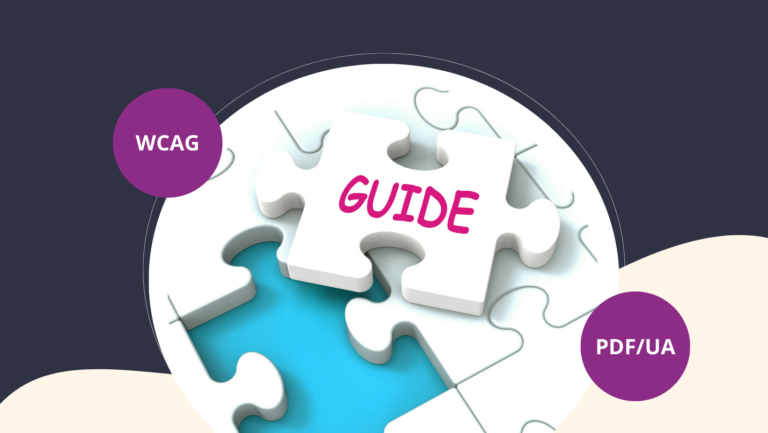The PDF format is widely used worldwide for disseminating information. It is therefore entirely legitimate to make our digital documents accessible – to ensure that everyone, regardless of their ability, has equal access to the information they contain. Our article examines the legal framework surrounding the accessibility of PDFs internationally – the standards, and the challenges to be aware of in order to promote an inclusive digital environment.
Overview of regulations and laws on PDF accessibility internationally
National laws supporting PDF accessibility vary from country to country, but many have adopted measures that align with the principles outlined in the United Nations Convention on the Rights of Persons with Disabilities (UNCRPD).
This international treaty, which has been ratified by numerous countries worldwide, requires signatory states to implement policies and measures promoting accessibility for persons with disabilities in various areas, including digital content.
Standards and guidelines for PDF accessibility
Among the standards that govern the design of accessible digital tools and services, we find:
The WCAG (Web Content Accessibility Guidelines)
These guidelines, currently in their version 2.2, encompass a wide range of recommendations aimed at improving the accessibility of websites.
The PDF/Universal Accessibility (PDF/UA) standard
The PDF/UA (Universal Access) standard is dedicated to making PDF documents accessible.
It promotes the creation of accessible PDF documents by providing guidance on design elements such as:
- Logical reading order for content
- Alternative text: Providing textual descriptions for non-text elements, such as images or graphics.
- Tagged PDF structure: Implementing a well-structured tagging system to facilitate navigation and comprehension of the content.
Read our article on the differences and complementarities between WCAG and PDF/UA.
National legislation and its compliance with international standards
While some countries have specific laws and guidelines regarding PDF accessibility, others rely on more general legislation concerning the rights of persons with disabilities.
Lately, we have addressed PDF accessibility in France.
In the United States, Section 508 of the Rehabilitation Act and the Americans with Disabilities Act (ADA) require that digital content, including PDF files, meet specific accessibility criteria.
The European Union has adopted Directive (EU) 2016/2102, which mandates the accessibility of websites and mobile applications of public sector bodies. Other countries, such as Canada and Australia, have also legislated in this area.
All these initiatives ensure that digital content, including PDF files, is accessible to everyone, echoing broader international standards of inclusion and accessibility.
Impacts of implementing accessible PDF files for content creators and organizations
The legal responsibility of businesses and public institutions regarding digital accessibility is significant.
Disability, particularly visual impairment, affects a significant portion of the population. It concerns 16% of the global population, which is 1.3 billion people.
While it’s important to produce a PDF that is 100% accessible according to the PDF/UA standard, focusing on usability for people with disabilities is even more crucial.
Benefits for people with disabilities
Universal access
Accessible PDF files enable people with disabilities to access and interact with digital content more easily and efficiently.
Furthermore, accessible PDFs can enhance the overall user experience, making digital content more engaging and user-friendly for all individuals, regardless of their abilities.
Inclusion and diversity in the digital environment
This is particularly important given the increasing reliance on digital content in all aspects of modern life, including education, employment, and social interactions.
Accessible PDFs can help eliminate barriers and equitably engage people with disabilities, enabling them to more fully participate in the digital world.
Positive effects on businesses and organizations
By complying with accessibility laws, organizations can avoid potential legal issues and demonstrate their commitment to social responsibility.
Furthermore, by catering to the needs of a broader audience, businesses and organizations can potentially expand their customer base and enhance their reputation as inclusive and forward-thinking entities.
Challenges and future perspectives
Technological barriers and limitations
These may include issues related to document formatting, font choices, and compatibility with assistive technology devices such as screen readers.
Lack of awareness and education about accessibility standards
Many content creators may not be aware of the specific requirements and best practices for making PDF documents accessible to people with disabilities. This can lead to unintentional barriers and exclusion for these users.
To address this issue, it is essential to promote awareness and education about accessibility standards, ensuring that content creators have the tools and knowledge necessary to create accessible PDFs. This can be achieved through training programs, resources, and guidelines that clearly outline the steps required to create accessible documents, while keeping in mind the unique needs of people with disabilities.
Differences in legal frameworks between countries
The laws and regulations governing digital accessibility can vary significantly from one country to another, making it challenging for content creators to navigate and comply with different standards.
For example, France has its own laws and specific obligations regarding accessibility. In contrast, other countries may follow different international standards. These different legal frameworks can create confusion and inconsistencies in PDF accessibility efforts.
In some countries like the USA, the issue is taken seriously, with authorities encouraging the search for compliant service providers and tools.
Toward an innovative solution to address the challenges of PDF accessibility internationally
The legal framework and standards regarding international PDF accessibility are essential to ensure equal access to information for all individuals, including those with disabilities.
An appeal to action is made to policymakers, content designers, and society as a whole to further commit to this cause.
Because digital accessibility has always been a matter of scale; advanced technology is needed to scale up. DocAxess offers an innovative approach based on cutting-edge AI that is unlike any other on the market..
A technology that can help you quickly address the challenges related to digital document accessibility issues.













